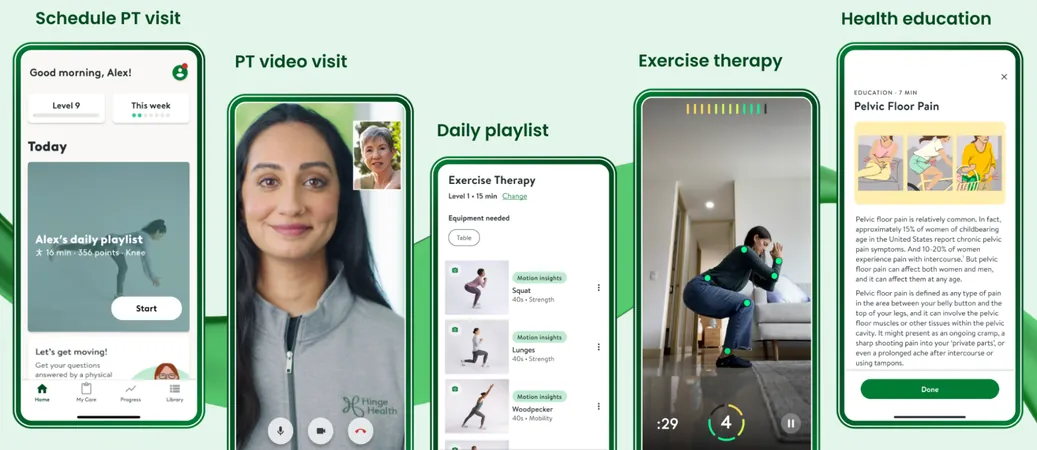
Breakthrough Digital Therapy Program Shows Promising Results for Women’s Pelvic Health
2025-01-11
Author: Daniel
Introduction
Chronic pelvic pain (CPP) affects a staggering 26% of women globally, significantly diminishing their quality of life. This complex condition, often defined by pain lasting for over three months, can arise from various biopsychosocial factors and often remains underdiagnosed and undertreated. A recent observational study explored how a digital musculoskeletal pelvic health program can address this pressing issue, providing hope for affected women.
Study Overview
This extensive study focused on a digital pelvic health initiative aimed at alleviating chronic pain, anxiety, and depression among women. Uniquely designed as a longitudinal, observational study, it included a comparison group to assess the efficacy of the digital program over 12 weeks. Participants engaged in digital exercise therapy, which incorporated customized exercise sessions, health education articles, and coaching, while the comparison group received only health education content.
Notable Findings
A total of 797 women participated, with demographic data indicating a mean age of 41.5 years and an average pain score of 45.7 out of 100 at the study's onset. The results revealed dramatic improvements among those in the intervention group. Pain levels for this group decreased by 44.5% at four weeks and an impressive 53.6% at twelve weeks, along with notable decreases in depression symptoms, suggesting the digital program's substantial impact.
In contrast, the comparison group experienced only a 21.6% reduction in pain at four weeks and 32.7% at twelve weeks. This emphasizes the digital program's potential, notably reducing the probability of moderate to severe depression symptoms by 11% compared to the nonparticipants at the twelve-week mark. While no significant differences were found in levels of anxiety between groups, the results overall provide compelling evidence in favor of digital health interventions.
Why Digital Therapy Works
The appeal of digital pelvic health programs lies in their accessibility and the reduction of traditional barriers to care, such as costs and scheduling conflicts. With the rise of telehealth, patients can engage in evidence-based pelvic floor physical therapy (PFPT) from home, making it easier to manage their condition and enhancing their overall well-being. Participants reported an average of 13.7 physical therapy sessions completed and 11.5 articles on health education read over the study period, highlighting strong engagement with the program.
Addressing the Economic Burden
Chronic pelvic pain not only affects individual quality of life but also imposes an enormous financial burden on healthcare systems. Estimates suggest that treatment costs for CPP can surpass $2.8 billion annually in the U.S. and result in $15 billion lost in productivity. Thus, programs like the digital pelvic health initiative not only promote better health outcomes but could also yield significant economic benefits by reducing healthcare expenses and enhancing workforce participation.
Conclusion and Future Directions
This pioneering study sheds light on the powerful effects of digital health programs for women suffering from chronic pelvic pain, demonstrating significant reductions in pain and depressive symptoms. While the study’s findings are promising, it also highlights the need for further research, including randomized controlled trials and longer follow-up periods to determine the sustained effectiveness of such digital interventions.
As healthcare continues to evolve in a digital age, the integration of technology in treatment approaches for chronic conditions like pelvic pain presents a potential game changer. Women suffering from CPP may find a newfound sense of relief and hope in these innovative digital solutions— paving the way for broader acceptance and application in mainstream healthcare.
Stay tuned for the latest updates on health innovations and groundbreaking studies that could change your life!





 Brasil (PT)
Brasil (PT)
 Canada (EN)
Canada (EN)
 Chile (ES)
Chile (ES)
 Česko (CS)
Česko (CS)
 대한민국 (KO)
대한민국 (KO)
 España (ES)
España (ES)
 France (FR)
France (FR)
 Hong Kong (EN)
Hong Kong (EN)
 Italia (IT)
Italia (IT)
 日本 (JA)
日本 (JA)
 Magyarország (HU)
Magyarország (HU)
 Norge (NO)
Norge (NO)
 Polska (PL)
Polska (PL)
 Schweiz (DE)
Schweiz (DE)
 Singapore (EN)
Singapore (EN)
 Sverige (SV)
Sverige (SV)
 Suomi (FI)
Suomi (FI)
 Türkiye (TR)
Türkiye (TR)
 الإمارات العربية المتحدة (AR)
الإمارات العربية المتحدة (AR)